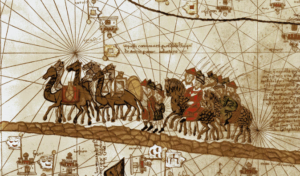The legendary food-travel writer Anthony Bourdain never fails to entertain me with his ways of writing. The video was constantly descriptive while being a little tongue and cheek at the same time when inconveniences would happen, like when the sailboat ran into the bridge and making them stuck in the river for a couple of hours.
The thing I liked the most out of the video was the rawness of its content. Bourdain makes jokes about not going to the pyramids and that he feels bad later for not going, but then immediately doesn’t feel bad about it at all. It reminds me of the theme of being a tourist, and finding a way to find something authentic, rather than something that is made up, hence him not wanting to go to the pyramids in the beginning, and overall avoiding them and leaving Cairo for dinner.
While the show is mainly about food, Bourdain still finds a way to finds the authentic pieces of society in Egypt. Centered around the different foods he visits cafes, farms where they raise and kill their food, and a funny joke is said at the café when the older gentleman Bourdain is talking to says that young people wouldn’t like the traditional café and that they want things a little more modern, and internet connectivity. I think it’s funny because it reminds me of the “generation complex” where older generations don’t think fondly of what younger people like, and if it isn’t traditional, then they don’t want it, but I digress.
Bourdain shows more than I expected from a 37-minute show. The episode was unexpectedly fast-paced, while not affecting the experience since I was able to retain the information with his impeccable narration. Bourdain’s background of being a chef in the past gives a good perspective on being open to foods, and had never said a bad thing about what he tried, all he would say is that “it will be good”. Openly saying that different cultures food he had never tried before is delicious if you have the desire to try it. Even when spending a night in the desert with a group of people, he says that he knew they were going to kill the goat for their dinner, and came back after just seeing the alive goat, smelling it covered with seasonings. I was not caught off guard, I guess his reaction just comes with years of culinary experience.
Maybe the reaction in the back of my head is caused by the American society that I have been used to, which is way more capitalist and materialistic centric compared to other cultures.
Finally, the last piece that had my attention the entire time was the authenticity at the end. Spending a night in the desert, he explains that this is someone’s open area to reset and that some people that are attracted to water, or the forest, and analyzed and said: “no wonder why the Europeans found this place so fascinating”. Implying that when you travel to exotic places they tend to have a unique identity, that can reset or change a person in their experience. Overall I absolutely loved this episode.
 www.kickvick.com/77-powerful-photos/
www.kickvick.com/77-powerful-photos/ Overview
Overview